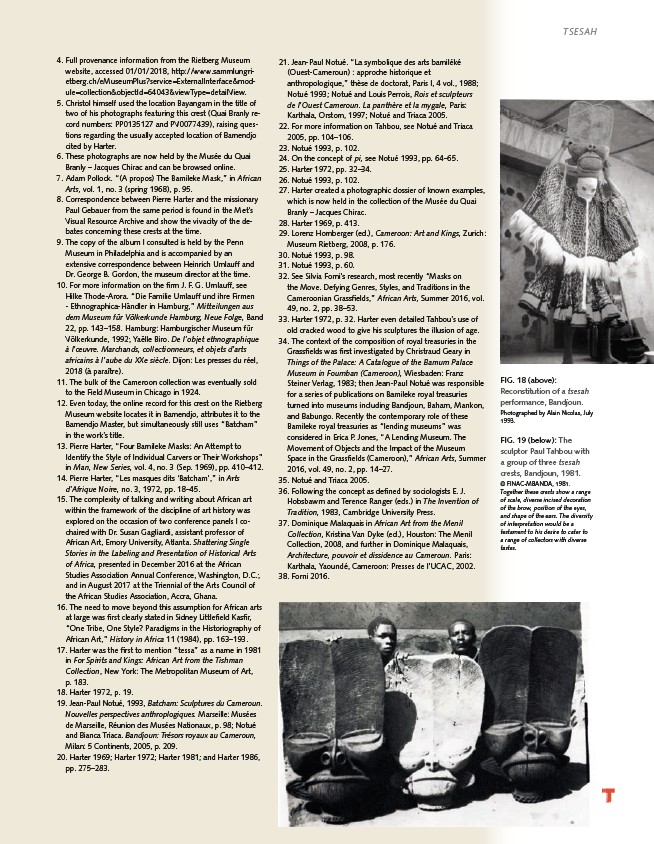
TSESAH
21. Jean-Paul Notué. “La symbolique des arts bamiléké
(Ouest-Cameroun) : approche historique et
anthropologique,” thèse de doctorat, Paris I, 4 vol., 1988;
Notué 1993; Notué and Louis Perrois, Rois et sculpteurs
de l’Ouest Cameroun. La panthère et la mygale, Paris:
Karthala, Orstom, 1997; Notué and Triaca 2005.
22. For more information on Tahbou, see Notué and Triaca
2005, pp. 104–106.
23. Notué 1993, p. 102.
24. On the concept of pi, see Notué 1993, pp. 64–65.
25. Harter 1972, pp. 32–34.
26. Notué 1993, p. 102.
27. Harter created a photographic dossier of known examples,
which is now held in the collection of the Musée du Quai
Branly – Jacques Chirac.
28. Harter 1969, p. 413.
29. Lorenz Homberger (ed.), Cameroon: Art and Kings, Zurich:
Museum Rietberg, 2008, p. 176.
30. Notué 1993, p. 98.
31. Notué 1993, p. 60.
32. See Silvia Forni’s research, most recently “Masks on
the Move. Defying Genres, Styles, and Traditions in the
Cameroonian Grassfi elds,” African Arts, Summer 2016, vol.
49, no. 2, pp. 38–53.
33. Harter 1972, p. 32. Harter even detailed Tahbou’s use of
old cracked wood to give his sculptures the illusion of age.
34. The context of the composition of royal treasuries in the
Grassfi elds was fi rst investigated by Christraud Geary in
Things of the Palace: A Catalogue of the Bamum Palace
Museum in Foumban (Cameroon), Wiesbaden: Franz
Steiner Verlag, 1983; then Jean-Paul Notué was responsible
for a series of publications on Bamileke royal treasuries
turned into museums including Bandjoun, Baham, Mankon,
and Babungo. Recently the contemporary role of these
Bamileke royal treasuries as “lending museums” was
considered in Erica P. Jones, “A Lending Museum. The
Movement of Objects and the Impact of the Museum
Space in the Grassfi elds (Cameroon),” African Arts, Summer
2016, vol. 49, no. 2, pp. 14–27.
35. Notué and Triaca 2005.
36. Following the concept as defi ned by sociologists E. J.
Hobsbawm and Terence Ranger (eds.) in The Invention of
Tradition, 1983, Cambridge University Press.
37. Dominique Malaquais in African Art from the Menil
Collection, Kristina Van Dyke (ed.), Houston: The Menil
Collection, 2008, and further in Dominique Malaquais,
Architecture, pouvoir et dissidence au Cameroun. Paris:
Karthala, Yaoundé, Cameroon: Presses de l’UCAC, 2002.
38. Forni 2016.
FIG. 18 (above):
Reconstitution of a tsesah
performance, Bandjoun.
Photographed by Alain Nicolas, July
1993.
FIG. 19 (below): The
sculptor Paul Tahbou with
a group of three tsesah
crests, Bandjoun, 1981.
© FINAC-MBANDA, 1981.
Together these crests show a range
of scale, diverse incised decoration
of the brow, position of the eyes,
and shape of the ears. The diversity
of interpretation would be a
testament to his desire to cater to
a range of collectors with diverse
tastes.
4. Full provenance information from the Rietberg Museum
website, accessed 01/01/2018, http://www.sammlungrietberg.
ch/eMuseumPlus?service=ExternalInterface&module=
collection&objectId=64043&viewType=detailView.
5. Christol himself used the location Bayangam in the title of
two of his photographs featuring this crest (Quai Branly record
numbers: PP0135127 and PV0077439), raising questions
regarding the usually accepted location of Bamendjo
cited by Harter.
6. These photographs are now held by the Musée du Quai
Branly – Jacques Chirac and can be browsed online.
7. Adam Pollock. “(A propos) The Bamileke Mask,” in African
Arts, vol. 1, no. 3 (spring 1968), p. 95.
8. Correspondence between Pierre Harter and the missionary
Paul Gebauer from the same period is found in the Met’s
Visual Resource Archive and show the vivacity of the debates
concerning these crests at the time.
9. The copy of the album I consulted is held by the Penn
Museum in Philadelphia and is accompanied by an
extensive correspondence between Heinrich Umlauff and
Dr. George B. Gordon, the museum director at the time.
10. For more information on the fi rm J. F. G. Umlauff, see
Hilke Thode-Arora. “Die Familie Umlauff und ihre Firmen
- Ethnographica-Händler in Hamburg,” Mitteilungen aus
dem Museum für Völkerkunde Hamburg, Neue Folge, Band
22, pp. 143–158. Hamburg: Hamburgischer Museum für
Völkerkunde, 1992; Yaëlle Biro. De l’objet ethnographique
à l’oeuvre. Marchands, collectionneurs, et objets d’arts
africains à l’aube du XXe siècle. Dijon: Les presses du réel,
2018 (à paraître).
11. The bulk of the Cameroon collection was eventually sold
to the Field Museum in Chicago in 1924.
12. Even today, the online record for this crest on the Rietberg
Museum website locates it in Bamendjo, attributes it to the
Bamendjo Master, but simultaneously still uses “Batcham”
in the work’s title.
13. Pierre Harter, “Four Bamileke Masks: An Attempt to
Identify the Style of Individual Carvers or Their Workshops”
in Man, New Series, vol. 4, no. 3 (Sep. 1969), pp. 410–412.
14. Pierre Harter, “Les masques dits ‘Batcham’,” in Arts
d’Afrique Noire, no. 3, 1972, pp. 18–45.
15. The complexity of talking and writing about African art
within the framework of the discipline of art history was
explored on the occasion of two conference panels I cochaired
with Dr. Susan Gagliardi, assistant professor of
African Art, Emory University, Atlanta. Shattering Single
Stories in the Labeling and Presentation of Historical Arts
of Africa, presented in December 2016 at the African
Studies Association Annual Conference, Washington, D.C.;
and in August 2017 at the Triennial of the Arts Council of
the African Studies Association, Accra, Ghana.
16. The need to move beyond this assumption for African arts
at large was fi rst clearly stated in Sidney Littlefi eld Kasfi r,
“One Tribe, One Style? Paradigms in the Historiography of
African Art,” History in Africa 11 (1984), pp. 163–193.
17. Harter was the fi rst to mention “tessa” as a name in 1981
in For Spirits and Kings: African Art from the Tishman
Collection, New York: The Metropolitan Museum of Art,
p. 183.
18. Harter 1972, p. 19.
19. Jean-Paul Notué, 1993, Batcham: Sculptures du Cameroun.
Nouvelles perspectives anthroplogiques. Marseille: Musées
de Marseille, Réunion des Musées Nationaux, p. 98; Notué
and Bianca Triaca. Bandjoun: Trésors royaux au Cameroun,
Milan: 5 Continents, 2005, p. 209.
20. Harter 1969; Harter 1972; Harter 1981; and Harter 1986,
pp. 275–283.